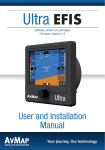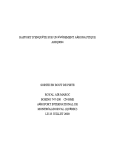Download DFC90 and DFC100 FAQs Rev 5
Transcript
DFC90 and DFC100 FAQs General Questions What are the main differences between the DFC90 and DFC100? There are two functional differences between and the autopilots and two architectural differences. Functionally, the DFC100 supports the R9 Vectors mode and it adds a VNAV capability. Architecturally, the DFC90 autopilot takes its input from the PFD and the Garmin 430s while the DFC100 is driven by the IFD and the Avidyne FMS 400/900w system, and the DFC100 system communicates to the rest of the R9 system via the Byteflight digital databus while the DFC90 does not. What are the main features of these autopilots? First and foremost, since it is taking advantage of the on-board PFD digital ADAHRS, they are able to provide a much more precise operation (e.g. no overshoots, no wandering, no divergent behavior inside the FAF, etc). Secondly, they add some very specific safety features such as Straight and Level and Envelope Protection. Thirdly, they add new modes such as IAS (Indicated Air Speed) mode. Finally, the Flight Director becomes much easier to use and follow. How does IAS mode work? Just like VS mode, IAS mode can be used to follow a commanded indicated airspeed as set by a new IAS bug or it can be used to perform an altitude capture at a specified airspeed. Once set via the IAS bug and engaged, the autopilot will adjust the aircraft flight path angle as required to track the commanded IAS. The system will not “descend to climb” or “climb to descend”. In other words, if you were currently flying at 120 KIAS and commanded a 1000’ climb at 140 KIAS, the aircraft will not first descend to pick up airspeed before climbing to the new altitude target. Likewise, if you were currently flying at 120 KIAS and commanded a 1000’ descent at 90 KIAS, the aircraft will not first climb to bleed off airspeed before descending to the new altitude target at 90 KIAS. In both cases, since the autopilot determines that it cannot comply with the contradictory input requests, it was hold current state until the pilot takes an action such as a power change or a target speed change. Why did you retain some of the same user interface as the S-TEC? This was purposely done to minimize the amount of re-training required for the S-TEC user community. Habit patterns are a powerful force and we wanted to leave that as intact as feasible. Where can I learn more about the “button-ology” of the DFC autopilots? These will be fully addressed in the autopilot user’s manuals. Do I still need to use the AP and FD buttons on the instrument panel? No, those buttons become non-functional in DFC90 and DFC100 integrations. In fact, as part of the installation, those buttons are removed and replaced by a cover plate. Is there anything else in PFD Release 8? No, Release 8 PFD is a point release designed solely to integrate with the DFC90 autopilot. There were some internal wiring modifications performed on the hardware in order to take advantage of the existing Rev 5 – 11/21/09 aircraft wiring and some associated software modifications to drive the DFC90 and that is all. Is there an on/off switch to the DFC autopilots? If not, how do I turn it on? No, there is no on/off switch for the DFC autopilot. It is wired just like the S-TEC 55X and does not have any on/off switch. It reuses the old S-TEC circuit breaker and is wired to the Essential bus. How much power/current does the DFC autopilot use? The DFC90 pulls 0.25A when no servos are in operation and up to 0.9A with all servos operating at 100% duty cycle. How much does the DFC autopilot weigh? Both the DFC90 and DFC100 autopilots weigh 2 pounds. This is 0.5 pounds lighter than the S-TEC systems they are replacing. Are there any other sources of information where I can learn more about the autopilot products or programs? Avidyne is hosting frequent webinars now on the DFC series of autopilots. Our products page of our website also contains some more information at http://avidyne.com/products/dfc90/index.asp and http://avidyne.com/products/dfc100/index.asp . We are also providing occasional Twitter tweets that are providing periodic program and product updates under the Twitter Username “AviJake”. Installation Questions What do you expect the install time to be? Avidyne is estimating 3 labor hours for installers to perform the complete install and checkout. The entire installation consists of a initial aircraft “rigging goodness” check (estimated to be 30 minutes), the removal/replacement of the S-TEC 55X from its tray, replaced by the DFC90/100 (this takes approximately 5 minutes) and in the case of the DFC90 system, the replacement of the PFD with a DFC-compatible PFD (this takes approximately 30 minutes plus a pitotstatic leak check) and then a system checkout. Avidyne is encouraging the system checkout to involve a nominal flight test to verify modes in-air. What kind of warranty will the DFC autopilot have? How about a Rel 8 PFD? The autopilot will have a 2-year warranty following installation and the PFD will have a 6month warranty attached to it if not covered by Flex and 6 months or end of Flex, whichever is longer, if covered by Flex. Will the DFC autopilot fall under the Platinum Warranty service? Yes, both the DFC autopilot and the upgraded PFD are eligible for Platinum service Is a Rel 8 PFD backward compatible with a S-TEC 55X? Yes it is. Release 8 PFDs will be able to support both the 55X, 55SR, and DFC90 autopilots. Rev 5 – 11/21/09 What happens to the removed S-TEC autopilot? The removed S-TEC is returned to Avidyne as part of the installation process. There is no market for used S-TEC autopilots that we are aware of and those autopilots are aircraft make/model specific. Are there any calibrations required? No, there are no calibrations required after installation. This is part of the “digital dividend”. Should I still put in a roll servo? No, Avidyne does not recommend spending the time or money on this upgrade. The DFC90 will not even “talk” to the roll servo. What if I already had the roll servo upgrade to my airplane? This will be unused in DFC configurations. It can and will be left in your airplane but the DFC autopilot does not control the roll servo at all. Do I need to keep the turn coordinator? Yes, the turn coordinator remains in the airplane and the DFC autopilots use that output as a comparator with the Avidyne ADAHRS data. If a miscompare is noted, the pilot is alerted to that condition, the autopilot will kick off, and the pilot can then manually re-engage the autopilot if so desired. How can I be sure the DFC autopilot is right for my aircraft? Avidyne intends to have the installers perform a quick check of your aircraft rigging and the servo health to ensure your aircraft is properly configured to take advantage of all that the DFC autopilot has to offer. Failure Mode Questions Will the DFC90 work after a loss of air data? Yes, modes such as Straight and Level and Pitch Roll still work without air data. The system can still track an ILS without air data as well. Will the DFC90 work after a loss of AHRS (attitude) data? No, the DFC90 will not work without AHRS input. This will come down to a personal tradeoff – would you rather have much higher performance and a safer system all the time, or a poorer performing autopilot that has some form of “limp home” capability? This is much less a factor in DFC100 systems since it uses a dual IFD input in the Platinum configuration. Training Questions What kind of training materials exist now or will exist for the DFC series of autopilots? The User's manual for the DFC series Autopilots is in draft and coming soon. When available, links will be posted here. Our goal is that the end-user training is complete in the same few hours that the airplane is down for the installation. Rev 5 – 11/21/09 Performance Questions How does the DFC autopilot achieve a “ride on rails” performance level using the existing S-TEC servo and trim cartridges? In the pitch axis, we are commanding both the pitch servo AND the pitch trim servo all the time. We call it a trimmervator. Because of slop and spring detent, the two servos sometimes compete for control of the aircraft, so giving them synchronized inputs ensures the elevator will do the right thing either way. Meanwhile, differential commands create trim. In roll, the spring cartridge is not dynamically involved, and the principal difficulty is the high servo starting voltage, which is compensated for in software. Also you may wish to refer to our engineer's blog post on servo system details if you're interested in more information. This is accessible through the Avidyne Live forum at http://avidynelive.com/forum_posts.asp . How can I be sure my aircraft will see better performance with a DFC autopilot? You will. A digital autopilot is really just a bunch of equations but not all equations are created equal and ours are better. We have an altitude estimator, gain scheduling, cross feeds, feed forward, lift calculations and range-to-go estimations. The results are better flight. You will see this at high altitudes, high speeds, altitude lost in turns, stability in 50 knot crosswinds, course captures from any reasonable position or attitude, ILS captures at 7 miles and 90 deg intercepts, no more s-turning during captures, etc. What is the maximum intercept angle the DFC can smoothly accomplish? 179.9 degrees. Does the DFC autopilot perform the same VS step down as it approaches the target altitude that the S-TEC does? No it does not. An Entegra-55X combination system would gradually step down the VS rate as you approach the target altitude and some customers found that round off to be too gradual. The Entegra-DFC system has a quicker and more precise level off capability. Can you explain more about the Underspeed protection that comes with Envelope Protection? Underspeed protection is designed to prevent autopilot-induced stall conditions. If, between a combination of power settings or commanded climb conditions result in a decaying airspeed to be approximately 1.2 Vstall, the autopilot will: provide an annunciation on the PFD that UNDERSPEED is active; provide an aural alert in your headset that speed protection mode is active; and will adjust the aircraft flight path angle and/or bank angle as required to maintain 1.2 Vstall. The system will stay in this state until there is sufficient energy/airspeed to provide the original commanded state through a pilot-commanded action such as adding power or changing the commanded condition (e.g. lowering the requested climb rate, increasing the requested IAS value, etc). The autopilot needs to be engaged in some mode for this protection to be active. Envelope protection is also functional in Flight Director only operations. Can you explain more about the Overspeed protection that comes with Envelope Protection? Overspeed protection is designed to prevent autopilot-induced overspeed conditions. For Vne aircraft, this protection kicks in right at Vne. As the aircraft reaches Rev 5 – 11/21/09 Vne, the autopilot will: provide an annunciation on the PFD that OVERSPEED is active; provide an aural alert in your headset that speed protection mode is active; and will adjust the aircraft flight path angle as required to maintain Vne. The system will stay in this state until a pilot-commanded action such as reducing power or changing commanded pitch is made. The autopilot needs to be engaged in some mode for this protection to be active. Envelope protection is also functional in Flight Director only operations. Will the existing servos wear out with the DFC autopilot like they are in S-TEC systems? No. While the flight controls are still actuated frequently in a DFC system, the magnitude of motor actuator movements are substantially smaller. Think of it this way – the entire time you are hand-flying the airplane, you are overpowering the spring cartridges and flexing them a lot more than their typically undeflected state when under autopilot control. Will the DFC autopilot work well in an aircraft that does not have a pitch servo (only has pitch trim servo)? Yes. One of the test aircraft used in development is a pitch trim only SR20 and we have found the performance to be on-par with full-servo’d aircraft. Schedule, Pricing and Availability Questions How much will these autopilots cost? Pricing (and any introductory or promotional deals) are published on the Avidyne website at http://avidyne.com/products/dfc100/index.asp http://avidyne.com/products/dfc90/index.asp I’ve got an older PFD (pre-Release 7). Am I eligible for this upgrade? Yes. As of mid-November 2009, there is an introductory offer that allows for an upgrade at the same price as Release 7 customers. This is a temporary promotion that expires before the end of the year. Starting in 2010, there will be an additional charge to bring the PFD up to Release 7 levels and then the Release 8 fee. What if I didn’t have Flight Director before – will I have Flight Director following an upgrade to DFC and is there an extra charge? If you did not have flight director prior to an upgrade to DFC90, you will have it as part of the basic DFC90 package and there is no extra charge for that. When will the autopilots be available for installation? Both the DFC90 and DFC100 autopilots are on the same approximate delivery schedule. Avidyne is confident they will both be delivering by mid-2010. We are always looking for ways to improve those schedules. The DFC90 variant will require a modified PFD in order to properly function. These “Mod 55” PFDs will have limited throughput from our factory service center and in order to allow immediate installation of the autopilot when it is certified, Avidyne is encouraging pre-R9 customers to upgrade their PFDs now. This PFD upgrade is included in the overall DFC90 price. Rev 5 – 11/21/09 Will the DFC100 work in Silver and Gold configurations in addition to the Platinum configuration? Yes, the DFC100 autopilot will fully operate in the R9 Silver and Gold configurations. Will the DFC90 be certified for other aircraft? If so, what and when? Aside from the Cirrus family of aircraft and the PA46 Matrix and Mirage, there are no other platforms that the system will support at this time. If you are interested in a specific make/model of aircraft, it is in your best interest to contact Avidyne Sales and make your voice heard. Will the DFC90 work with SRV aircraft (those with S-TEC 55SR)? Yes it will. The upgrade of a 55SR to a DFC90 results in the full-featured DFC90 system, no missing or degraded elements. How do I get upgrades to the DFC autopilot if they come out? The DFC series of autopilots will have what is called a Field Loadable Software capability. That means that if a software upgrade is available, the system can be uploaded in the field at an approved installation/service center and does not need to come back to the Avidyne factory for upgrade. Pricing policy for future upgrades has not been fully established at this time. Will the DFC90 be upgradeable to a DFC100? Yes. It will require a trip to the Avidyne factory service center for that conversion. Conversion pricing has not yet been determined. Rev 5 – 11/21/09







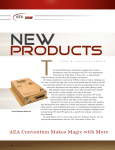
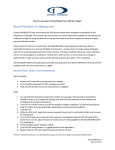

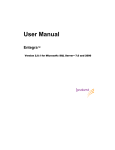
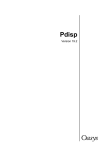

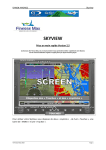


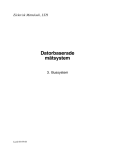
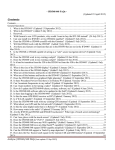

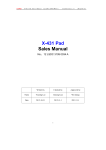
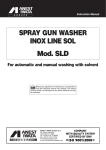


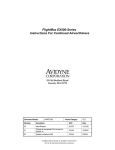
![U.S. Version [Last Updated on: Jun 13th, 2014]](http://vs1.manualzilla.com/store/data/005873845_1-0370c7761d3b42576ec2ae1fd24c9e75-150x150.png)
